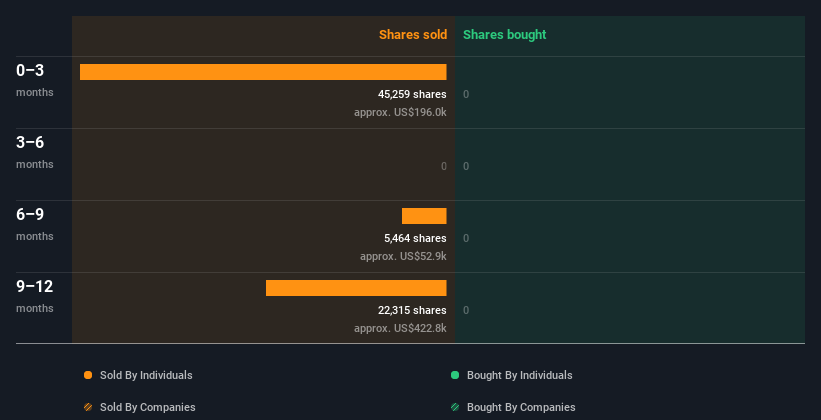
Investors may wish to note that the Director of Cerence Inc., Thomas Beaudoin, recently netted US$87k from selling stock, receiving an average price of US$7.21. It might not be a huge sale, but it did reduce their holding size 10%, hardly encouraging.
View our latest analysis for Cerence
Cerence Insider Transactions Over The Last Year
The insider, Stefan Ortmanns, made the biggest insider sale in the last 12 months. That single transaction was for US$230k worth of shares at a price of US$19.26 each. While we don't usually like to see insider selling, it's more concerning if the sales take place at a lower price. It's of some comfort that this sale was conducted at a price well above the current share price, which is US$6.69. So it may not tell us anything about how insiders feel about the current share price.
In the last year Cerence insiders didn't buy any company stock. The chart below shows insider transactions (by companies and individuals) over the last year. By clicking on the graph below, you can see the precise details of each insider transaction!

If you like to buy stocks that insiders are buying, rather than selling, then you might just love this free list of companies. (Hint: Most of them are flying under the radar).
Insider Ownership Of Cerence
Looking at the total insider shareholdings in a company can help to inform your view of whether they are well aligned with common shareholders. Usually, the higher the insider ownership, the more likely it is that insiders will be incentivised to build the company for the long term. It appears that Cerence insiders own 3.6% of the company, worth about US$10m. We've certainly seen higher levels of insider ownership elsewhere, but these holdings are enough to suggest alignment between insiders and the other shareholders.
So What Do The Cerence Insider Transactions Indicate?
Insiders haven't bought Cerence stock in the last three months, but there was some selling. Looking to the last twelve months, our data doesn't show any insider buying. While insiders do own shares, they don't own a heap, and they have been selling. We're in no rush to buy! While it's good to be aware of what's going on with the insider's ownership and transactions, we make sure to also consider what risks are facing a stock before making any investment decision. To that end, you should learn about the 3 warning signs we've spotted with Cerence (including 1 which doesn't sit too well with us).
But note: Cerence may not be the best stock to buy. So take a peek at this free list of interesting companies with high ROE and low debt.
For the purposes of this article, insiders are those individuals who report their transactions to the relevant regulatory body. We currently account for open market transactions and private dispositions of direct interests only, but not derivative transactions or indirect interests.
New: AI Stock Screener & Alerts
Our new AI Stock Screener scans the market every day to uncover opportunities.
• Dividend Powerhouses (3%+ Yield)
• Undervalued Small Caps with Insider Buying
• High growth Tech and AI Companies
Or build your own from over 50 metrics.
Have feedback on this article? Concerned about the content? Get in touch with us directly. Alternatively, email editorial-team (at) simplywallst.com.
This article by Simply Wall St is general in nature. We provide commentary based on historical data and analyst forecasts only using an unbiased methodology and our articles are not intended to be financial advice. It does not constitute a recommendation to buy or sell any stock, and does not take account of your objectives, or your financial situation. We aim to bring you long-term focused analysis driven by fundamental data. Note that our analysis may not factor in the latest price-sensitive company announcements or qualitative material. Simply Wall St has no position in any stocks mentioned.
About NasdaqGS:CRNC
Cerence
Provides AI powered virtual assistants for the mobility/transportation market in the United States, rest of the Americas, Germany, rest of Europe, the Middle East, Africa, Japan, and rest of the Asia-Pacific.
Undervalued with moderate growth potential.

